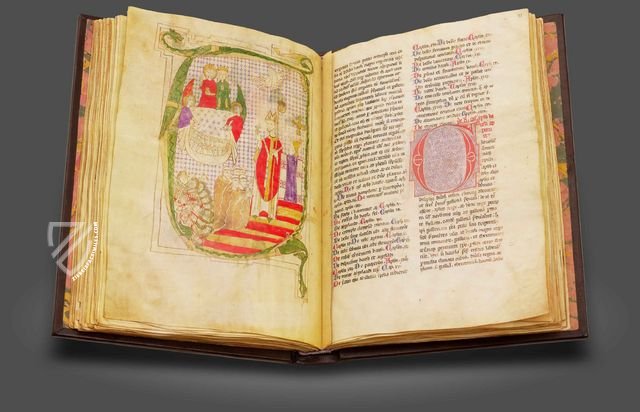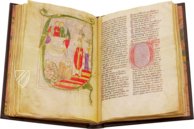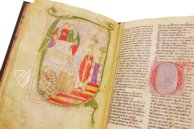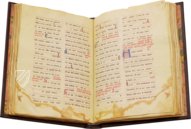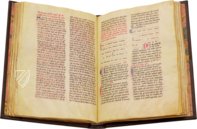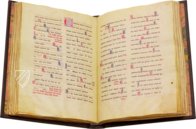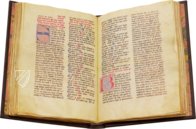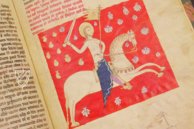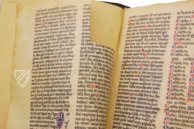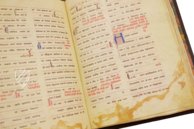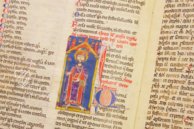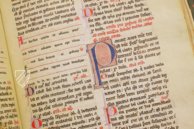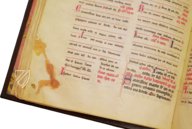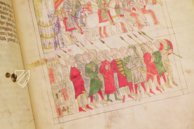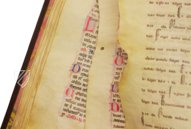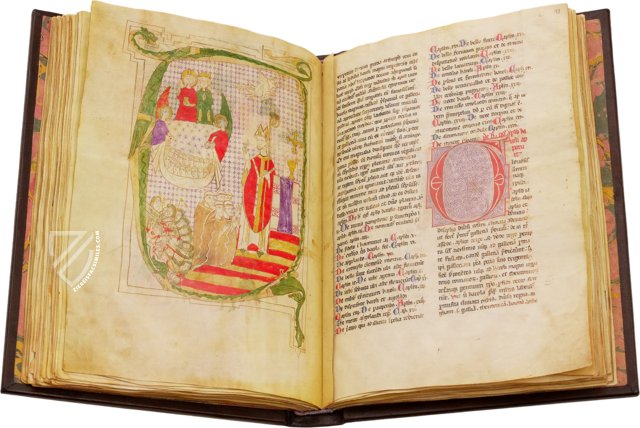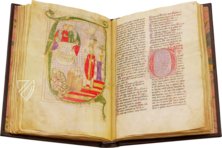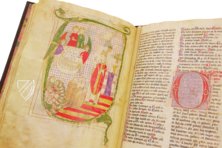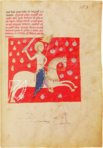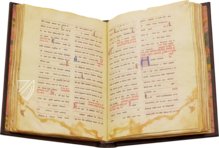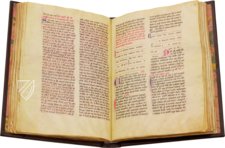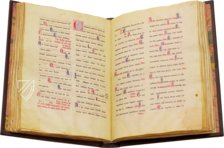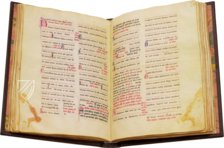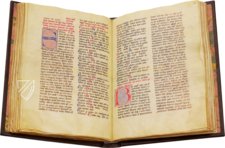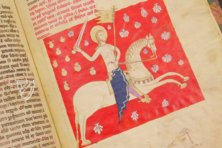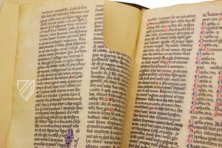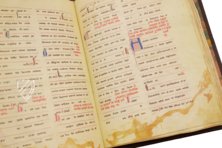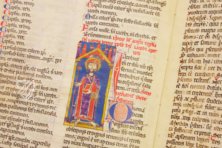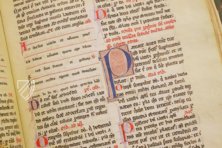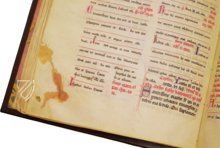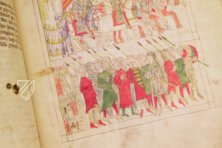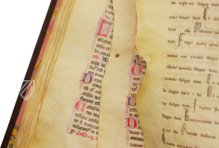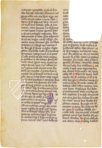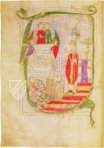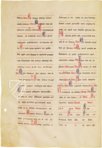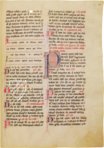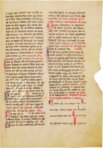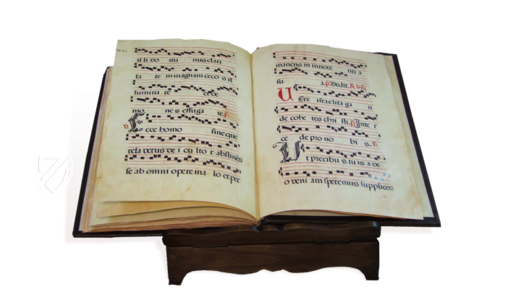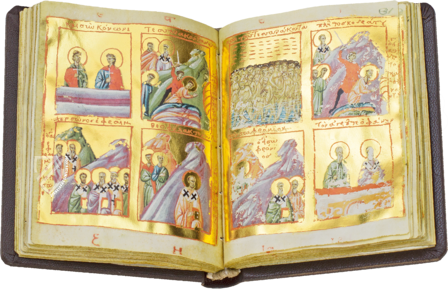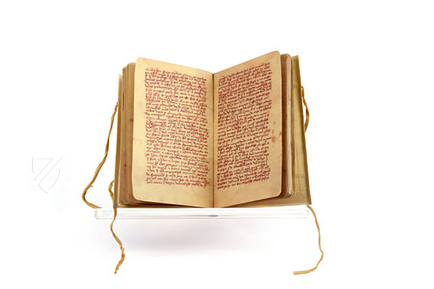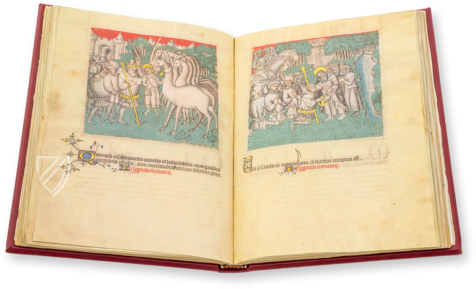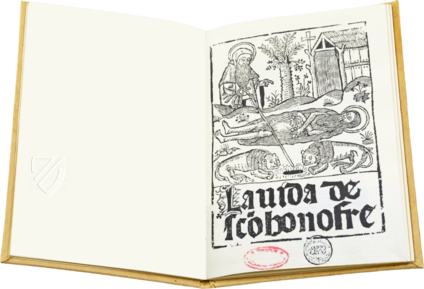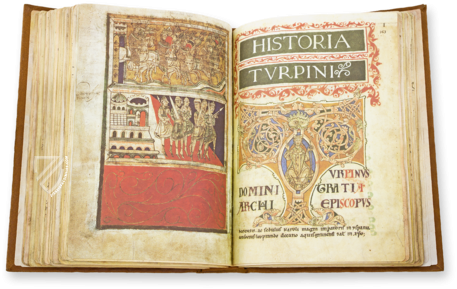Codex Calixtinus
(1,000€ - 3,000€)
The Salamanca codex of the Codex Calixtinus is one of five surviving manuscripts that contains the complete text of the Liber Sancti Iacobi, the Book of Saint James. It is named after Pope Calixtus II, to whom the work was originally attributed. Although modern scholars now believe it was written by another cleric shortly after the Pope’s death, each chapter is prefaced by a letter attributed to Callixtus II. Nonetheless, it is a precious manuscript depicting not only St. James the Great but also inter alia the army of Charlemagne and the famous chivalric hero Roland. The shrine dedicated to St. James in Santiago de Compostela Cathedral has been a pilgrimage destination as early as the 9th century and became so popular that an official pilgrimage guide was created. Other texts in the manuscript includes texts, prayers, and hymns for mass, 22 miracle stories about St. James, the story of the transfer of his corpse to Santiago, and an appendix with special, polyphonic songs.
Codex Calixtinus
For a considerable time, a pilgrimage to Santiago de Compostela has enjoyed considerable vogue and popularity. Yet this tradition of the pilgrims to the grave of St. James in the most northwestern part of Spain goes back to the 9th century. An official pilgrimage guide and fundament from the 12th century for the great cult around James the great, also known as James the Elder, is the so-called Liber Sancti Iacobi, also known as the Codex Calixtinus. The oldest example of this codex is found today in Santiago. Nevertheless, there is a precious copy of this manuscript from the 14th century stored in the Universidad de Salamanca. The liturgical texts, miracle stories, songs, and the medieval pilgrimage guide in particular allow the magic of this location – around the tomb of St. James – to still be comprehended today and allows us to understand why a pilgrimage to Santiago de Campostela has exerted such a great fascination over the centuries.
A Papal Document?
The Codex Calixtinus from Salamanca is one of five remaining manuscripts with the complete text of the Liber Sancti Iacobi. Alongside the oldest 12th century “original” in Santiago de Compostela and the 14th century copy in Salamanca, yet more examples exist in the British Library, in the Biblioteca Apostolica Vaticana, and in the Spanish National Library in Madrid. The famous Codex Calixtinus gained its name from the original ascription of the text to Pope Calixtus II (1119–1124). The texts probably originated from high-ranking clerics, including Aimeric Picaud, who delivered the codex to Santiago. Many legends and secrets wrap themselves around the book about St. James that were closely associated with the cult of James the Great throughout the Middle Ages and are up to today.
Exciting Legends and a Medieval Guidebook
According to the New Testament, Saint James was the brother of John the Evangelist and one of Christ’s disciples. He received martyrdom in the year 44. The legend of the transfer of his corpse to Spain, which founded the fame of Santiago de Compostela, has existed since the 9th century. An official basis for the cult of James, which enjoyed great fame, was accomplished in the 12th century with the Liber Sancri Iacobi. The collected manuscript contained texts, prayers, and hymns for mass, 22 miracle stories about St. James, the story of the transfer of his corpse to Santiago, and an appendix with special, polyphonic songs. The most famous part of the codex is nevertheless a pilgrimage guide, in which the various ways to Santiago de Compostela are described in detail and a manual was given to the pilgrims.
St. James and Charlemagne
The Codex Calixtinus is historically significant with regard to Charlemagne. The manuscript contains namely a historically significant 12th century forgery: the famous text of the so-called Pseudo-Turpin, also known as the Historia Karoli Magni et Rotholandi. This consisted of a collection of legends about the Spanish campaign of Charlemagne masquerading as the chronicle of Bishop Turpin of Rheims, a contemporary of Charlemagne. This was already exposed as a forgery in the 15th century. The Historia enjoyed great popularity and wide circulation in all of Europe and exercised various influences on art and literature. Thus the Codex Calixtinus contains biblical representations of this story about Charlemagne with Roland and Turpin alongside a miniature of James as a pilgrim. Both the great, luminous, brightly-colored design of the miniatures as well as the historically significant text of the codex originating from Salamanca in 1325 grant a wonderful glimpse in the world of medieval pilgrimages and stories.
Codicology
- Alternative Titles
- Codex Calixtinus de la Universidad de Salamanca
Codex Calixtinus of the University of Salamanca
Liber Sancti Jacobi
Codice Calistino
Códice Calixtino
Liber Sancti Jacobi - Size / Format
- 246 pages / 33.1 × 24.5 cm
- Origin
- Spain
- Date
- Ca. 1325
- Epochs
- Style
- Language
- Script
- Gothic Textura
- Illustrations
- 5 miniatures including 2 full-pages, a historiated initial with a portrait of Pope Calixtus II and many smaller decorative initials in red and blue
- Content
- Liber Sancti Iacobi, 22 miracle stories about St. James, the story of the transfer of his corpse to Santiago, letters attributed to Callixtus II, texts, prayers, and hymns for mass, polyphonic songs
Codex Calixtinus
St. James as a Knight
The image of St. James as a knight is tied to the medieval legend of Santiago Matamoros or “Saint James the Moor-Slayer”. During the mythical Battle of Clavijo, he miraculously appeared to fight for the Christian army against the Moors, giving rise to the battle cry “St. James and strike for Spain!” The scallop, which is James’ emblem, is incorporated into the Cross of Saint James, symbol of the Military Order of Santiago, and is featured on both the flag and in the background of this miniature.
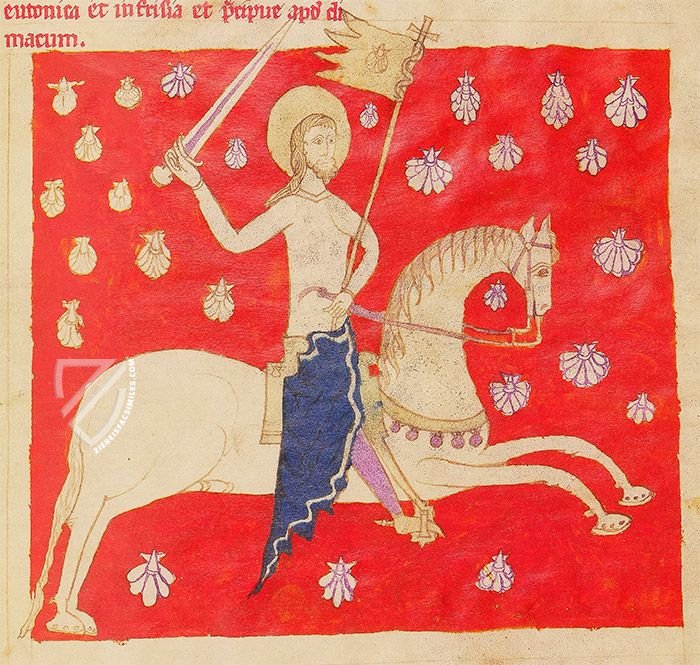
Codex Calixtinus
Vision of Archbishop Turpin
This historiated “T” initial consists of four green dragons, who frame a scene depicting Archbishop Turpin celebrating mass, together with some kneeling clergymen. He has a vision of two angels carry the souls of Roland and his fallen companions before Christ, giving the sign of the benediction, and the Virgin Mary, crowned as Queen of Heaven with her hands folded in prayer.
The Devil is shown flying over the head of the Archbishop, who stands next to an altar with a golden cross and chalice. This implies that he is fleeing after playing a role in the ambush of the Christian army of the Franks by pagans at the Battle of Roncevaux Pass. The scene has a patterned background of purple squares and circles, except for the stars of heaven.
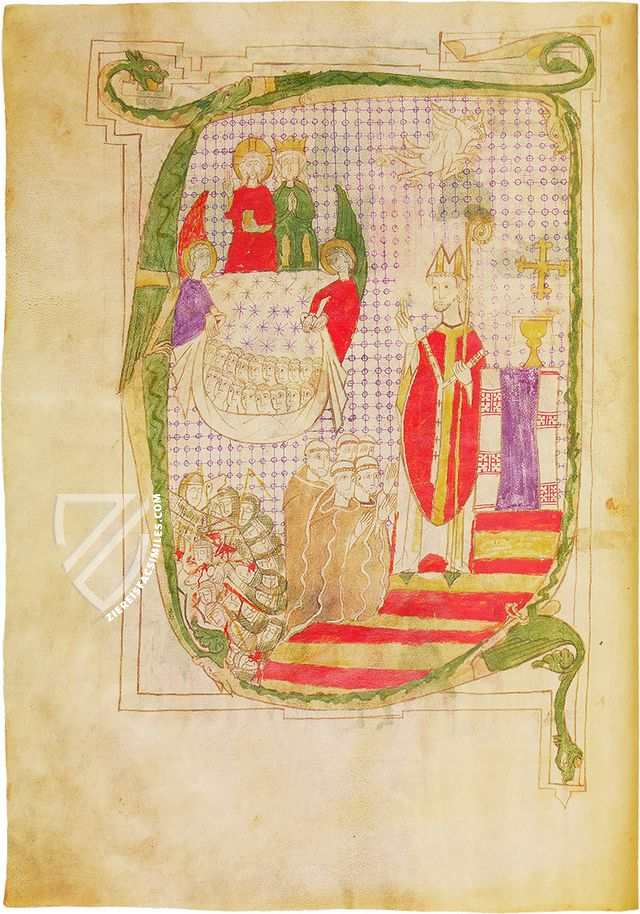
#1 Codex Calixtinus de la Universidad de Salamanca
(1,000€ - 3,000€)
- Treatises / Secular Books
- Apocalypses / Beatus
- Astronomy / Astrology
- Bestiaries
- Bibles / Gospels
- Chronicles / History / Law
- Geography / Maps
- Saints' Lives
- Islam / Oriental
- Judaism / Hebrew
- Single Leaf Collections
- Leonardo da Vinci
- Literature / Poetry
- Liturgical Manuscripts
- Medicine / Botany / Alchemy
- Music
- Mythology / Prophecies
- Psalters
- Other Religious Books
- Games / Hunting
- Private Devotion Books
- Other Genres
- Afghanistan
- Armenia
- Austria
- Belgium
- Belize
- Bosnia and Herzegovina
- China
- Colombia
- Costa Rica
- Croatia
- Cyprus
- Czech Republic
- Denmark
- Egypt
- El Salvador
- Ethiopia
- France
- Germany
- Greece
- Guatemala
- Honduras
- Hungary
- India
- Iran
- Iraq
- Israel
- Italy
- Japan
- Jordan
- Kazakhstan
- Kyrgyzstan
- Lebanon
- Liechtenstein
- Luxembourg
- Mexico
- Morocco
- Netherlands
- Palestine
- Panama
- Peru
- Poland
- Portugal
- Romania
- Russia
- Serbia
- Spain
- Sri Lanka
- Sweden
- Switzerland
- Syria
- Tajikistan
- Turkey
- Turkmenistan
- Ukraine
- United Kingdom
- United States
- Uzbekistan
- Vatican City
- A. Oosthoek, van Holkema & Warendorf
- Aboca Museum
- Ajuntament de Valencia
- Akademie Verlag
- Akademische Druck- u. Verlagsanstalt (ADEVA)
- Aldo Ausilio Editore - Bottega d’Erasmo
- Alecto Historical Editions
- Alkuin Verlag
- Almqvist & Wiksell
- Amilcare Pizzi
- Andreas & Andreas Verlagsbuchhandlung
- Archa 90
- Archiv Verlag
- Archivi Edizioni
- Arnold Verlag
- ARS
- Ars Magna
- ArtCodex
- AyN Ediciones
- Azimuth Editions
- Badenia Verlag
- Bärenreiter-Verlag
- Belser Verlag
- Belser Verlag / WK Wertkontor
- Benziger Verlag
- Bernardinum Wydawnictwo
- BiblioGemma
- Biblioteca Apostolica Vaticana (Vaticanstadt, Vaticanstadt)
- Bibliotheca Palatina Faksimile Verlag
- Bibliotheca Rara
- Boydell & Brewer
- Bramante Edizioni
- Bredius Genootschap
- Brepols Publishers
- British Library
- C. Weckesser
- Caixa Catalunya
- Canesi
- CAPSA, Ars Scriptoria
- Caratzas Brothers, Publishers
- Carus Verlag
- Casamassima Libri
- Centrum Cartographie Verlag GmbH
- Chavane Verlag
- Christian Brandstätter Verlag
- Circulo Cientifico
- Club Bibliófilo Versol
- Club du Livre
- CM Editores
- Collegium Graphicum
- Collezione Apocrifa Da Vinci
- Comissão Nacional para as Comemorações dos Descobrimentos Portugueses
- Coron Verlag
- Corvina
- CTHS
- D. S. Brewer
- Damon
- De Agostini/UTET
- De Nederlandsche Boekhandel
- De Schutter
- Deuschle & Stemmle
- Deutscher Verlag für Kunstwissenschaft
- DIAMM
- Droz
- E. Schreiber Graphische Kunstanstalten
- Ediciones Boreal
- Ediciones Grial
- Ediclube
- Edições Inapa
- Edilan
- Editalia
- Edition Deuschle
- Edition Georg Popp
- Edition Leipzig
- Edition Libri Illustri
- Editiones Reales Sitios S. L.
- Éditions de l'Oiseau Lyre
- Editions Medicina Rara
- Editorial Casariego
- Editorial Mintzoa
- Editrice Antenore
- Editrice Velar
- Edizioni Edison
- Egeria, S.L.
- Eikon Editores
- Electa
- Emery Walker Limited
- Enciclopèdia Catalana
- Eos-Verlag
- Ephesus Publishing
- Ernst Battenberg
- Eugrammia Press
- Extraordinary Editions
- Fackelverlag
- Facsimila Art & Edition
- Facsimile Editions Ltd.
- Facsimilia Art & Edition Ebert KG
- Faksimile Verlag
- Feuermann Verlag
- Folger Shakespeare Library
- Franco Cosimo Panini Editore
- Friedrich Wittig Verlag
- Fundación Hullera Vasco-Leonesa
- G. Braziller
- Gabriele Mazzotta Editore
- Gebr. Mann Verlag
- Gesellschaft für graphische Industrie
- Getty Research Institute
- Giovanni Domenico de Rossi
- Giunti Editore
- Graffiti
- Grafica European Center of Fine Arts
- Guido Pressler
- Guillermo Blazquez
- Gustav Kiepenheuer
- H. N. Abrams
- Harrassowitz
- Harvard University Press
- Helikon
- Hendrickson Publishers
- Henning Oppermann
- Herder Verlag
- Hes & De Graaf Publishers
- Hoepli
- Holbein-Verlag
- Houghton Library
- Hugo Schmidt Verlag
- Idion Verlag
- Il Bulino, edizioni d'arte
- ILte
- Imago
- Insel Verlag
- Insel-Verlag Anton Kippenberger
- Instituto de Estudios Altoaragoneses
- Instituto Nacional de Antropología e Historia
- Introligatornia Budnik Jerzy
- Istituto dell'Enciclopedia Italiana - Treccani
- Istituto Ellenico di Studi Bizantini e Postbizantini
- Istituto Geografico De Agostini
- Istituto Poligrafico e Zecca dello Stato
- Italarte Art Establishments
- Jan Thorbecke Verlag
- Johnson Reprint Corporation
- Josef Stocker
- Josef Stocker-Schmid
- Jugoslavija
- Karl W. Hiersemann
- Kasper Straube
- Kaydeda Ediciones
- Kindler Verlag / Coron Verlag
- Kodansha International Ltd.
- Konrad Kölbl Verlag
- Kurt Wolff Verlag
- La Liberia dello Stato
- La Linea Editrice
- La Meta Editore
- Lambert Schneider
- Landeskreditbank Baden-Württemberg
- Leo S. Olschki
- Les Incunables
- Liber Artis
- Library of Congress
- Libreria Musicale Italiana
- Lichtdruck
- Lito Immagine Editore
- Lumen Artis
- Lund Humphries
- M. Moleiro Editor
- Maison des Sciences de l'homme et de la société de Poitiers
- Manuscriptum
- Martinus Nijhoff
- Maruzen-Yushodo Co. Ltd.
- MASA
- Massada Publishers
- McGraw-Hill
- Metropolitan Museum of Art
- Militos
- Millennium Liber
- Müller & Schindler
- Nahar - Stavit
- Nahar and Steimatzky
- National Library of Wales
- Neri Pozza
- Nova Charta
- Oceanum Verlag
- Odeon
- Orbis Mediaevalis
- Orbis Pictus
- Österreichische Staatsdruckerei
- Oxford University Press
- Pageant Books
- Parzellers Buchverlag
- Patrimonio Ediciones
- Pattloch Verlag
- PIAF
- Pieper Verlag
- Plon-Nourrit et cie
- Poligrafiche Bolis
- Presses Universitaires de Strasbourg
- Prestel Verlag
- Princeton University Press
- Prisma Verlag
- Priuli & Verlucca, editori
- Pro Sport Verlag
- Propyläen Verlag
- Pytheas Books
- Quaternio Verlag Luzern
- Reales Sitios
- Recht-Verlag
- Reichert Verlag
- Reichsdruckerei
- Reprint Verlag
- Riehn & Reusch
- Roberto Vattori Editore
- Rosenkilde and Bagger
- Roxburghe Club
- Salerno Editrice
- Saltellus Press
- Sandoz
- Sarajevo Svjetlost
- Schöck ArtPrint Kft.
- Schulsinger Brothers
- Scolar Press
- Scrinium
- Scripta Maneant
- Scriptorium
- Shazar
- Siloé, arte y bibliofilia
- SISMEL - Edizioni del Galluzzo
- Sociedad Mexicana de Antropología
- Société des Bibliophiles & Iconophiles de Belgique
- Soncin Publishing
- Sorli Ediciones
- Stainer and Bell
- Studer
- Styria Verlag
- Sumptibus Pragopress
- Szegedi Tudomànyegyetem
- Taberna Libraria
- Tarshish Books
- Taschen
- Tempus Libri
- Testimonio Compañía Editorial
- Thames and Hudson
- The Clear Vue Publishing Partnership Limited
- The Facsimile Codex
- The Folio Society
- The Marquess of Normanby
- The Richard III and Yorkist History Trust
- Tip.Le.Co
- TouchArt
- TREC Publishing House
- TRI Publishing Co.
- Trident Editore
- Tuliba Collection
- Typis Regiae Officinae Polygraphicae
- Union Verlag Berlin
- Universidad de Granada
- University of California Press
- University of Chicago Press
- Urs Graf
- Vallecchi
- Van Wijnen
- VCH, Acta Humaniora
- VDI Verlag
- VEB Deutscher Verlag für Musik
- Verlag Anton Pustet / Andreas Verlag
- Verlag Bibliophile Drucke Josef Stocker
- Verlag der Münchner Drucke
- Verlag für Regionalgeschichte
- Verlag Styria
- Vicent Garcia Editores
- W. Turnowski Ltd.
- W. Turnowsky
- Waanders Printers
- Wiener Mechitharisten-Congregation (Wien, Österreich)
- Wissenschaftliche Buchgesellschaft
- Wissenschaftliche Verlagsgesellschaft
- Wydawnictwo Dolnoslaskie
- Xuntanza Editorial
- Zakład Narodowy
- Zollikofer AG

